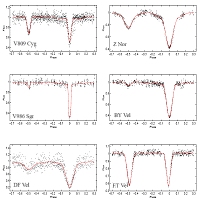First light curve analysis of 20 eclipsing binaries with INTEGRAL's OMC
19 January 2009
Photometric data gathered by INTEGRAL's Optical Monitoring Camera (OMC) has been used to study selected eclipsing binary stars for which the light curve had hitherto not been analyzed. This recent study by Petr Zasche (Astronomical Institute, Charles University in Prague) provides new key information on the basic properties of these binary systems - properties that were previously not known or only estimated with low precision.
 |
|
Figure 1. Selection of folded light curves of six eclipsing binaries from the study of twenty such binary systems by Petr Zasche. Credit: P. Zasche |
The INTEGRAL spacecraft is equipped with instruments dedicated to observe the high energy (3 keV to 10 MeV) Universe. It also performs simultaneous observations in the optical (500-600 nm, Johnson V band) with the Optical Monitoring Camera. The OMC not only targets the objects observed simultaneously by the two gamma-ray instruments and the X-ray monitor, but also observes serendipitous objects in its field of view.
In a paper to appear in the February 2009 issue of New Astronomy, Zasche presents results from a study of twenty eclipsing binaries – binary star systems in which the two orbiting stars regularly pass in front of each other as seen from Earth. The study is based on data from serendipitous observations stored in the OMC archive (see Editor's notes).
The advantage of the OMC
The OMC is a good tool for the study of variable stars, such as eclipsing binaries, because the instrument can observe a specific target uninterrupted for many hours, up to about 2.5 days, with no gap in the data (which on ground can be caused for example by bad weather). This is particularly useful for binary systems with an orbital period of a few days - these require long observation times in order to be able to determine the entire light curve.
Selection and light curve analysis
The twenty binary systems in this study were selected on the basis that their light curves had not been analysed before, and that they had a large number of OMC data points. Using the OMC photometric data, Zasche performed the first analysis of the folded light curves for these binary systems. Figure 1 shows the folded light curve for six of the eclipsing binaries in this study.
Analysis of the folded light curves yielded several orbital parameters of these binary star systems including the orbital period and the inclination of the orbits relative to the line of sight. In addition, a number of other basic properties such as the relative contribution of each star to the total luminosity, the relative sizes of the two stars and the ratio of the masses of the two stars were also derived. The deepest minimum in the light curve was defined to correspond with the eclipse of the primary star by the secondary star.
Study results and future work
Zasche finds that all but one of the 20 studied binary systems are detached systems. The orbital period lies between 1 and ~5 days for most of the binaries in this study, with only one of the systems having a shorter period (~18 hours) and one having a longer period (~10.4 days). One binary system (ET Vel) was found to have an eccentric orbit with e=0.0737. For ten systems the radius of the secondary star is found to be larger than that of the primary star. In five of the binary systems there is indication of a possible third component.
Based on serendipitous OMC data, this study has provided the first set of orbital and physical parameters for this sub-set of eclipsing binary systems. The results of this study have also confirmed the previously determined orbital periods. Further improvements and determination of the absolute values rather than the relative values of the physical properties will require spectroscopic studies and observations at different wavelengths.
Related publication
Zasche, P., Data mining: "The data mining: An analysis of 20 eclipsing binary light-curves observed by the INTEGRAL/OMC", New Astronomy, 14, February 2009
Editor's notes
The Optical Monitoring Camera onboard INTEGRAL observes optical emission from the prime targets of the INTEGRAL gamma-ray instruments. It also obtains serendipitous observations of a large number of optically variable objects in its field of view. This data is pre-processed by the INTEGRAL Science Data Centre (ISDC) and is subsequently archived in the OMC archive (see related link in the right-hand menu) maintained by the Laboratorio de Astrofísica Espacial y Física Fundamental (LAEFF). LAEFF was founded in 1991 as a collaboration between INTA, CSIC and ESA, and is situated at the European Space Astronomy Centre (ESAC), Spain.

